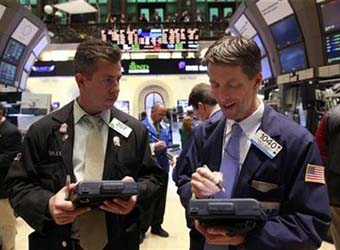U.S. equities closed at all-time highs on Friday, as the major indexes posted their best week since the election.
The Dow Jones industrial average rose about 130 points heading into the close, with 3M and Apple contributing the most gains. The Nasdaq composite gained about 0.5 percent, as Apple advanced more than 1.5 percent.
“It’s a great time; everyone’s having fun. But people need to remember that bull markets don’t end on pessimism; they end in euphoria. I’d advise people to not get too euphoric,” said Sean O’Hara, director at Pacer Financial.
The S&P 500 gained 0.6 percent, with consumer staples and health care leading advancers.
“People are predisposed to think stocks are maybe going to pay less in taxes” and that we’re getting better economic data in the future, said Kim Forrest, senior equity analyst at Fort Pitt Capital. “I think we’re in the clear for a little while.”
All major indexes have been hitting record highs since the election. In fact, the Dow has notched 14 record closes since then and gains in 20 of the past 24 sessions.
The Dow, S&P 500, and Nasdaq also did something they haven’t done in more than five years: all three rose each day of this trading week. The last time all three rose every day during the same trading week was September 2011.
“I’m frankly surprised that we’ve kept breaking into new highs,” said Randy Frederick, vice president of trading and derivatives at Charles Schwab. “The fundamentals aren’t terrible, but the valuations have gotten really high. The economic data has been modest, but not great.”
“If the market is really being driven by optimism, I can’t see that changing until the new administration takes office,” said Frederick.
President-elect Donald Trump shocked the world by defeating former Secretary of State Hillary Clinton, who was the heavy favorite to win. Since then, optimism over fiscal stimulus, deregulation of certain sectors and tax cuts has flooded the market.
The small-caps Russell 2000 and the S&P Mid Cap 400 have easily outperformed the Dow, S&P and Nasdaq since Nov. 8, rising 16 percent and 12 percent, respectively.
“is this sustainable? Yes. The market is a forward-looking indicator. If in fact we get regulatory reforms, [small and mid-cap stocks] will benefit greatly from that,” said Pacer’s O’Hara. “It’s going to help large caps, but it’s the small and mid caps that that will benefit the most.”
The U.S. stock market has also managed to brush off a number of potentially detrimental events, including a key referendum in Italy and the European Central Bank’s decision to scale back its quantitative easing program, starting in April 2017.
Investors will be bracing for a Federal Reserve meeting set for next week, with the U.S. central bank largely expected to announce tighter monetary policy on Wednesday. According to the CME Group’s FedWatch tool, market expectations for a rate hike next week are above 95 percent.
“With yesterday’s ECB decision quickly fading from our rearview mirror, next Wednesday’s FOMC meeting survives as the lone potential landmine that could give investors pause before boosting their risk,” said Jeremy Klein, chief market strategist at FBN Securities, in a note.
“Although the Fed will likely add restrictive measures for only the second time in a decade, the announcement arguably has far less uncertainty surrounding it than usual. Janet Yellen and her colleagues have unambiguously signaled a desire to pull the trigger at its next gathering and will surprise no one by doing so,” he said.
In economic news, consumer sentiment for December hit its highest level since January 2015 and wholesale inventories for October showed a decline of 0.4 percent.
“The Trump enthusiasm continues as the UoM consumer confidence index rose to 98 from 93.8 in November,” said Peter Boockvar, chief market analyst at The Lindsey Group, in a note. “With the rise in optimism, we’ll soon see to what extent this translates into a change in economic behavior.”
U.S. Treasurys fell on Friday, with the two-year note yield rising to 1.1369 percent, while the benchmark 10-year yield advancing to 2.4665 percent. The U.S. dollar rose 0.54 percent against a basket of currencies, building on Thursday’s sharp gains following the ECB’s announcement.
The Dow Jones industrial average rose 142.04 points, or 0.72 percent, to 19,756.85, with Coca-Cola leading advancers and Caterpillar the biggest decliner.
The S&P 500 gained 13.34 points, or 0.59 percent, to close at 2,259.53, with consumer staples leading nine sectors higher and real estate and materials lagging.
The Nasdaq composite advanced 27.14 points, or 0.5 percent, to end at 5,444.50.
Advancers and decliners were about even at the New York Stock Exchange, with an exchange volume of 884.5 million and a composite volume of 3.822 billion at the close.
The CBOE Volatility Index (VIX), widely considered the best gauge of fear in the market, traded lower, near 11.8.
High-frequency trading accounted for 52 percent of December’s daily trading volume of about 7.86 billion shares, according to TABB Group. During the peak levels of high-frequency trading in 2009, about 61 percent of 9.8 billion of average daily shares traded were executed by high-frequency traders.
Gold futures for February delivery fell $10.50 to settle at $1,161.90 per ounce. In oil markets, U.S. crude for January delivery rose 1.3 percent to settle at $51.50 per barrel.
Source: CNBC



